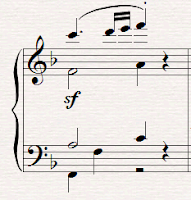
Beethoven changes the character of the main theme in his string arrangement as well. But he doesn't change it in quite the same way. Recall that the exposition of the piano version featured octave doublings of the melody on beat three of each measure, which gave beat three a little extra weight:

What else does Beethoven change? To begin with, he gives the cello an eighth note (rather than a sixteenth note rest followed by a sixteenth note) on the downbeat of measure 91. This change was predictable. Beethoven has consistently had the strings begin passages together for ease of ensemble playing.
He also adds some harmonic interest to the passage by using different descending scales in the second half of each measure. The descending scales outline, in order, the harmonies V/IV, IV, and V. Note the E-flats in measures 91 and 92. These E-flats were not present in the piano version. Here, they tonicize the subdominant, giving the theme a more grandiose feeling.
Finally, note his scoring of measure 94. In the exposition, he scored this measure as follows, using the second violin and viola to add support to the high F in the first violin.
In the recapitulation, he lets the first violin trail off by itself, not wishing to slow down the action by the sudden introduction of half notes in the middle strings.



No comments:
Post a Comment